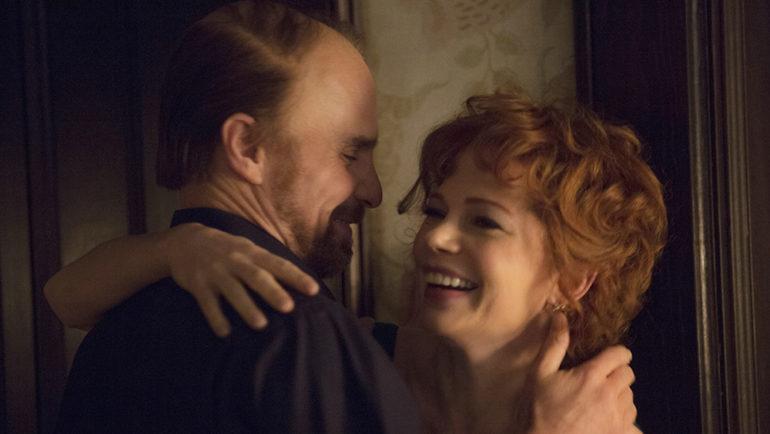TV Review: ‘Fosse/Verdon’
By Daniel D’Addario
LOS ANGELES (Variety.com) – Bob Fosse’s signature style as a director and choreographer was stripped-down and then askew, removing familiar excesses of movement or film language so that he might replace them with entirely new flourishes. Every chance he got, he traded cant and familiarity with an insinuating slinkiness, suggestive both of his vaudeville influences and of a creative mind unusually familiar with the language in which temptation expresses itself.
“Fosse/Verdon,” FX’s series about the lives of the artist and his collaborator and wife, the musical actress Gwen Verdon, depicts the pair’s process with a tactician’s clear understanding of how musicals, and choreography, work. (Little wonder: The show’s first two episodes are helmed by Thomas Kail, director of “Hamilton,” and written by Steven Levenson, who penned the book for “Dear Evan Hansen.”) It makes the intertwined work of a choreographer and his lead dancer feel credibly real, and identifies precisely what about Fosse’s work felt so unusual, sometimes quite explicitly. “I want to see every muscle, every tendon,” Fosse (Sam Rockwell) declares at one point; in one of the show’s earliest moments, Verdon (Michelle Williams) demonstrates “breaking the legs” into unexpected angles during a beat-by-beat building of a musical number, one that’s done wholly collaboratively.
“Fosse/Verdon” moves through the work its two leads made together, with a chronology that’s just scrambled enough to lend an air of arty oddity while staying user-friendly. We meet Fosse minutes before his death, then jump back to the filming of a box-office bomb (“Sweet Charity”) and its follow-up, a hit (“Cabaret,” for which Fosse would win his Oscar); Verdon, we learn, was integral to the success of both. In the second episode, we learn how the pair met, with a then-married Fosse repeating what had become a well-established pattern of disrupting his home life by forging a new romance during rehearsals.
All of which, much like the depiction of the creative process, feels real enough. But something, some fundamental jazziness, is missing. One trusts the biographical rigor of this series — one that was based on a biography by Sam Wasson and that credits Fosse and Verdon’s real-life daughter, Nicole Fosse, as a creative consultant — but it doesn’t catch the imagination the way the best backstage stories do. Indeed, part of the problem may be that the Fosse/Verdon collaboration, hinging on the contributions of the female helpmeet who also happened to be an undersung artist in her own right, really did resemble something that’s become a seen-it-before trope on TV, even despite the enduring power of the art the pair made.
When, for instance, Williams’s Verdon describes the “gorilla” sequence in “Cabaret,” which she rightly understands as a parable about the power of love to transcend prejudice at times suffused with hate, we remember the impact of Fosse’s work. When the gorilla mask becomes a totem for her own dutifulness and diligence as wife and creative partner (she crosses the Atlantic, from the “Cabaret” set to New York and back again, to fetch and deliver it), the device calls attention to its own balefulness and loses its power, becoming something closer to kitsch. Williams, a richly talented singer who can really move on stage, makes a compelling Verdon — when she’s dancing. With her feet on the ground, though, she’s facing off against TV’s latest brick wall, a character whose roiling internal conflict expresses itself both through misbehavior and a kind of impassable stoicism. Despite his manifold talents, Rockwell doesn’t crack Fosse from the show’s beginning; at least in the early going, his Fosse is less interesting than his work.
That becomes the central problem of the show: Who, precisely, is it for? Admirers of Fosse’s work will have the work to return to. (And the work, indeed, remains: One of “Fosse/Verdon’s” early miscalculations is depicting the filming of “Cabaret” and thus forcing a comparison between the very game Kelli Barrett and the character she’s playing — Liza Minnelli, who delivered one of the most memorably electric performances ever put to film.) And the uninitiated will see in Fosse and Verdon two characters moving through very familiar choreography — young love followed by painful recrimination, a step forward, then two back. Ryan Murphy’s “Feud,” another limited series about the private lives of legends, wasn’t just liberated by its ability to embroider imaginatively on what facts were known. It was also made with verve and high-stepping willingness to reimagine what form an episode of television could take, indulging the obsessiveness of its creator and the inherent melodrama of its protagonists.
But those were movieland divas vivified by a movie-mad TV impresario, one whose new visions are now to be housed by Netflix, with FX seeking other creators to help define their brand. Fosse and Verdon were, like the “Fosse/Verdon” team, creatures of Broadway, with all the stoicism that implies. (A set can shut down to accommodate an errant performer, but onstage, the curtain goes up at eight no matter what.) They gave practically everything of themselves to their art — and as a result, have precious little remaining to give any viewer genuinely curious about their inner lives. All that’s left to play are the sort of familiar beats Fosse and Verdon stripped down and reshaped in their work. That work was the joint project of two lifetimes, and as a reclamation project publicizing the influence of Verdon on well-loved pieces of theater and film, “Fosse/Verdon” is worthy. As television, it can’t find a rhythm that feels like its own.
“Fosse/Verdon.” FX. April 9. Eight episodes (two screened for review).
Cast: , , Norbert Leo Butz, Margaret Qualley, Paul Reiser, Aya Cash, Nate Corddry, Evan Handler, Susan Misner, Kelli Barrett, Bianca Marroquin, Blake Baungartner.
Executive Producers: Thomas Kail, Steven Levenson, Lin-Manuel Miranda, Joel Fields, Sam Rockwell, Michelle Williams, and George Stelzner.

